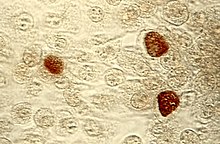
Back متدثرة تراخومية Arabic متدثره تراخوميه ARZ Chlamydia trachomatis Bulgarian Chlamydia trachomatis Catalan Chlamydia trachomatis Czech Chlamydia trachomatis Danish Chlamydia trachomatis German Chlamydia trachomatis Spanish Chlamydia trachomatis Basque کلامیدیا تراکوماتیس Persian
| Chlamydia trachomatis | |
|---|---|

| |
| Chlamydia trachomatis in brown | |
| Scientific classification | |
| Domain: | Bacteria |
| Phylum: | Chlamydiota |
| Class: | Chlamydiia |
| Order: | Chlamydiales |
| Family: | Chlamydiaceae |
| Genus: | Chlamydia |
| Species: | C. trachomatis
|
| Binomial name | |
| Chlamydia trachomatis (Busacca 1935) Rake 1957 emend. Everett et al. 1999[1]
| |
| Synonyms | |
| |
Chlamydia trachomatis (/kləˈmɪdiə trəˈkoʊmətɪs/), commonly known as chlamydia,[2] is a bacterium that causes chlamydia, which can manifest in various ways, including: trachoma, lymphogranuloma venereum, nongonococcal urethritis, cervicitis, salpingitis, pelvic inflammatory disease. C. trachomatis is the most common infectious cause of blindness and the most common sexually transmitted bacterium.[3]
Different types of C. trachomatis cause different diseases. The most common strains cause disease in the genital tract, while other strains cause disease in the eye or lymph nodes. Like other Chlamydia species, the C. trachomatis life cycle consists of two morphologically distinct life stages: elementary bodies and reticulate bodies. Elementary bodies are spore-like and infectious, whereas reticulate bodies are in the replicative stage and are seen only within host cells.
- ^ J.P. Euzéby. "Chlamydia". List of Prokaryotic names with Standing in Nomenclature. Retrieved 2008-09-11.
- ^ "Chlamydia trachomatis". Retrieved 2015-11-18.[dead link]
- ^ Cite error: The named reference
Elwell2016was invoked but never defined (see the help page).
© MMXXIII Rich X Search. We shall prevail. All rights reserved. Rich X Search